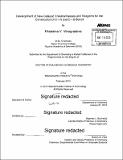Development of new catalytic transformations and reagents for the construction of C-N and C-S bonds
Author(s)
Vinogradova, Ekaterina V. (Ekaterina Viktorovna)
DownloadFull printable version (38.47Mb)
Other Contributors
Massachusetts Institute of Technology. Department of Chemistry.
Advisor
Stephen L. Buchwald.
Terms of use
Metadata
Show full item recordAbstract
Chapter 1. Palladium-Catalyzed Cross-Coupling of Aryl Chlorides and Triflates with Sodium Cyanate: A Practical Synthesis of Unsymmetrical Ureas. An efficient method for palladium-catalyzed cross-coupling of aryl chlorides and triflates with sodium cyanate is reported. The protocol allows for the synthesis of unsymmetrical N,N'-di- and N,N,N'-trisubstituted ureas in one pot, and is tolerant of a wide range of functional groups. Insight into the mechanism of aryl isocyanate formation is gleaned through studies of the transmetallation and reductive elimination steps of the reaction, including the first demonstration of reductive elimination from an arylpalladium isocyanate complex to produce an aryl isocyanate. Chapter 2. Palladium-Catalyzed Synthesis of N-Aryl Carbamates. An efficient synthesis of aryl carbamates was achieved by performing palladiumcatalyzed cross-coupling of ArX (X = CI, OTf) with sodium cyanate in the presence of alcohols. The use of aryl triflates as electrophilic components in this transformation allowed for an expanded substrate scope for the direct synthesis of aryl isocyanates. This methodology provides direct access to major carbamate protecting groups, Sthiocarbamates, and diisocyanates, which are precursors to polyurethane materials. Chapter 3. Structural Reevaluation of the Electrophilic Hypervalent Iodine Reagent for Trifluoromethylthiolation. Hypervalent iodine [lambda]3-benziodoxoles are common electrophilic transfer reagents known for their enhanced stability compared to their non-cyclic analogues. Here we present data showing that chlorobenziodoxole reacts with two different thiolate nucleophiles (thiocyanate and trifluoromethylthiolate) resulting in the formation of stable thioperoxy complexes rather than the expected benziodoxole derivatives. We further report a revised structure for the earlier described electrophilic trifluoromethylthiolation reagent (1), previously believed to contain the benziodoxole framework. Our findings, which are based on a combination of analytical techniques, including the recently introduced crystalline sponge method for X-ray analysis, unambiguously demonstrate that 1 is a thioperoxy compound both in solution and the solid state. Chapter 4. Organometallic Palladium Reagents for Cysteine Bioconjugation. Organometallic palladium reagents for the selective S-arylation of biomolecules are described. This new bioconjugation toolkit provides a highly versatile technique for the fast functionalization of cysteine with aromatic scaffolds under a broad range of reaction conditions (e.g., pH, solvent, temperature). The resulting bioconjugates are stable under basic and acidic conditions, as well as in the presence of external thiol nucleophiles. The substitution pattern on the aryl ring can be varied to achieve high levels of stability toward oxidation. Lastly, new types of bio-therapeutics - stapled peptides and linker-free antibody-drug conjugates - could be synthesized using the new method.
Description
Thesis: Ph. D. in Organic Chemistry, Massachusetts Institute of Technology, Department of Chemistry, 2015. Cataloged from PDF version of thesis. Vita. Includes bibliographical references.
Date issued
2015Department
Massachusetts Institute of Technology. Department of ChemistryPublisher
Massachusetts Institute of Technology
Keywords
Chemistry.